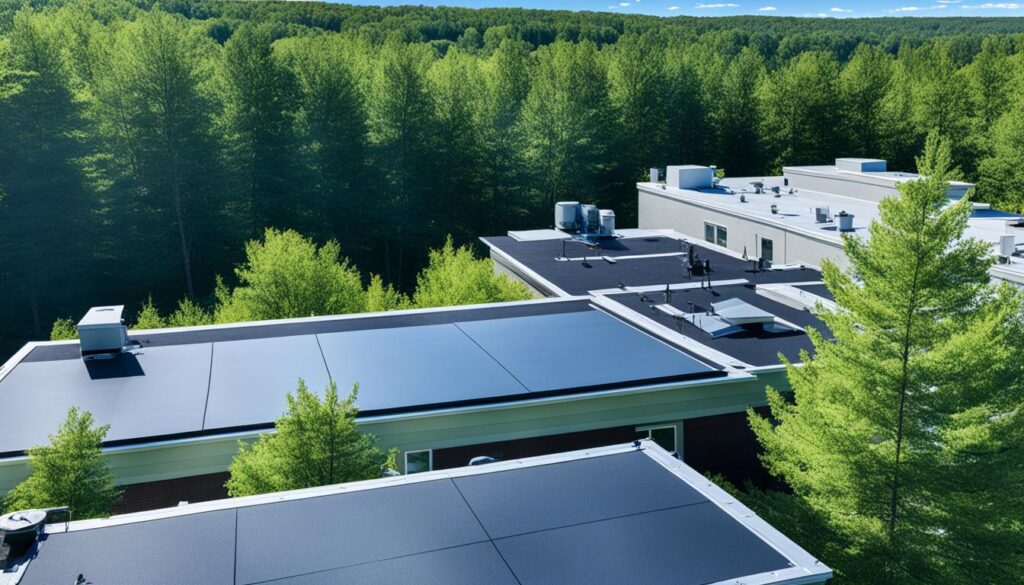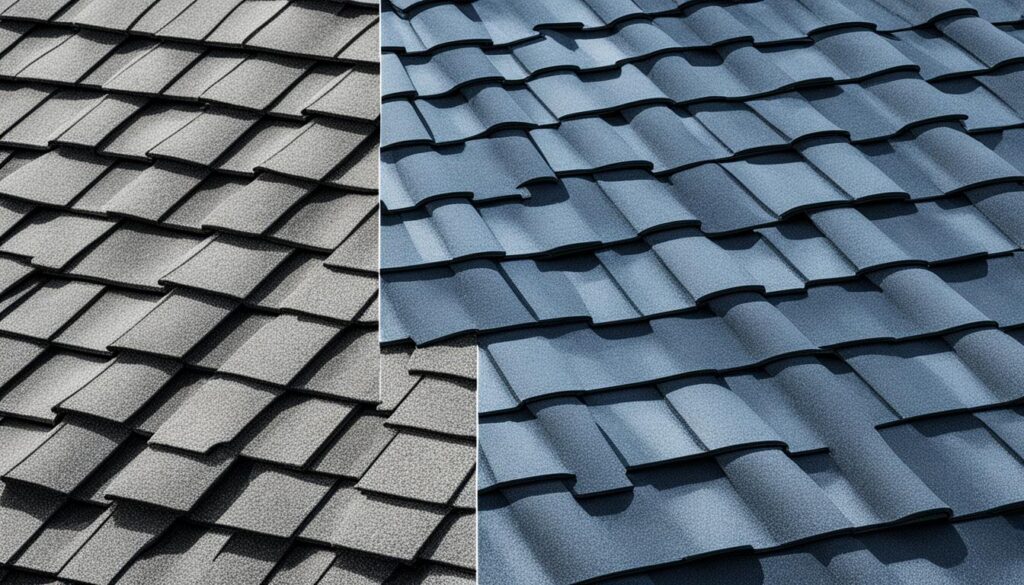When it comes to choosing the right roofing material for your home, there are several options to consider. However, two popular choices that often come up in the conversation are TPO and EPDM. But which one is truly the best? Are there certain situations where one outperforms the other? And what about the cost? In this article, we will compare TPO and EPDM based on durability, situation, and pricing to help you make an informed decision for your roof.
Before we dive into the details, let’s first understand what TPO and EPDM are. TPO stands for thermoplastic polyolefin, and it is a single-ply white membrane used for both commercial and residential roofing. On the other hand, EPDM stands for ethylene propylene diene terpolymer and is a black synthetic rubber membrane primarily used in commercial and medical facilities.
Key Takeaways:
- TPO and EPDM are popular choices for roofing materials.
- TPO is a single-ply white membrane, while EPDM is a black synthetic rubber membrane.
- The choice between TPO and EPDM depends on factors like durability, situation, and cost.
- Consider the specific location of your roof and the importance of heat reflection.
- The pricing of TPO and EPDM can vary based on factors like roof size and insulation used.
What are TPO and EPDM?
TPO (Thermoplastic Polyolefin) and EPDM (Ethylene Propylene Diene Terpolymer) are two widely used membrane roof systems for flat or low slope roofs. While both materials serve the same purpose, there are significant differences in their chemical makeup, coloring, and application.
TPO is a single-ply white membrane that is commonly used in both commercial and residential roofing. Its versatility and durability make it a popular choice for various applications. TPO membranes are known for their excellent resistance to ultraviolet (UV) radiation and extreme weather conditions.
EPDM, on the other hand, is a synthetic rubber black membrane primarily used in commercial and medical facilities. It is highly resistant to heat, ozone, and weathering. EPDM roofs have a proven track record of providing long-lasting protection against external elements.
The Major Difference: Color and Composition
The most noticeable difference between TPO and EPDM is their coloring. TPO membranes are typically white, which helps reflect sunlight and heat, reducing energy consumption and keeping the building cooler. In contrast, EPDM roofs are primarily black, allowing them to absorb heat and retain warmth.
In terms of composition, TPO is made from a blend of ethylene, propylene, and rubber fillers, providing it with excellent flexibility and resistance to tears and punctures. EPDM, on the other hand, is a synthetic rubber derived from oil and natural gas. Its unique formulation gives it unmatched durability and resistance to chemicals.
TPO and EPDM Applications
TPO membranes are widely used in both commercial and residential roofing due to their versatility and cost-effectiveness. They are especially suitable for large commercial buildings, shopping centers, and warehouses. TPO’s white surface also makes it a popular choice for residential roofs with living spaces directly underneath, as it helps reflect heat and maintain a comfortable indoor temperature.
EPDM is mainly used in commercial applications, particularly for buildings with large flat roofs. It is commonly found in hospitals, schools, manufacturing facilities, and office complexes. EPDM’s excellent weatherability and resistance to chemicals make it an ideal choice for environments where durability and longevity are crucial.
“TPO and EPDM, while similar in purpose, have unique characteristics that cater to different roofing needs. Whether it’s the white, energy-efficient TPO or the resilient and weather-resistant EPDM, both materials offer excellent performance and protection for flat or low slope roofs.”
Comparing Durability
When considering the durability of TPO (thermoplastic polyolefin) and EPDM (ethylene propylene diene terpolymer) roofing materials, it is important to note the lifespan of each option. TPO roofs typically have a lifespan of around 25 years when properly installed and maintained. On the other hand, EPDM roofs can last even longer, with a lifespan of 25 to 30 years for fully adhered 0.060 thickness EPDM roofing.
While EPDM is generally considered to be more durable than TPO, it is essential to highlight that both materials can provide a long-lasting roof when installed correctly. The difference in lifespan between TPO and EPDM may not be significant enough to heavily influence your decision when it comes to flat roof replacement.
It is worth noting that the durability of the roofing material alone is not the only factor that affects the overall durability of a roof. The quality of installation, regular maintenance, and climate conditions also play crucial roles in determining how long the roof will last.
Next, we will consider different situations where TPO and EPDM may be more suitable, assisting you in making an informed decision based on your specific needs and requirements.
Considering Different Situations
The choice between TPO and EPDM may depend on the specific situation and location of the roof. When it comes to flat roofs over living spaces or bedrooms, TPO is the recommended roofing material due to its heat reflection properties.
TPO’s white membrane reflects heat instead of absorbing it, helping to keep the room below cooler during the scorching summer months. This can result in more comfortable living conditions and reduced energy consumption for air conditioning.
On the other hand, EPDM’s black membrane has heat absorption properties, which can make the room below warmer. While this might be advantageous in colder climates or during the winter season, it may not be the ideal choice for areas where maintaining a lower room temperature is essential.
Additionally, the aesthetic aspect should be considered when choosing between TPO and EPDM. If the roof is visible from a window, TPO’s white membrane may become dirty and less visually appealing over time. In contrast, EPDM’s black membrane may not be as noticeable or prone to staining.
To summarize, TPO is best suited for flat roofs over living spaces or bedrooms that require heat reflection and maintaining cooler room temperatures. EPDM, on the other hand, may be more appropriate for areas where heat absorption and warmer room temperatures are desired, such as colder climates.
“The choice between TPO and EPDM ultimately depends on the specific situation and preferences of the homeowner. Consider factors like heat reflection, room temperature, and aesthetic preferences when making the decision.”
Below is a table summarizing the situational considerations for TPO and EPDM: 
| TPO | EPDM | |
|---|---|---|
| Suitable for Flat Roofs Over Living Spaces or Bedrooms | ✓ | ✗ |
| Heat Reflection Properties | ✓ | ✗ |
| Room Temperature | Cooler | Warmer |
| Aesthetic Concerns (Visible Roofs) | May become dirty over time | Less noticeable |
Comparing Cost
When considering the cost of TPO and EPDM membranes for your roof, several factors come into play. These factors include the size of the roof, the type of insulation used, and the installation method. It’s important to note that the prices provided here are for budgetary purposes and should not be considered the exact price for a membrane roof system.
For smaller projects, TPO and EPDM generally range in cost from $14.00 to $17.00 per square foot. On the other hand, larger projects tend to have a lower cost, with prices averaging around $12.00 per square foot.
| Factors | Average Cost Range ($ per square foot) |
|---|---|
| Size of Roof | $14.00 – $17.00 (smaller projects) $12.00 (larger projects) |
| Insulation Type | Varies depending on the specific insulation chosen |
| Installation Method | May affect labor costs or materials needed |
It’s important to remember that these numbers are general estimates and can vary depending on the specific circumstances of your roofing project. The size of your roof, choice of insulation, and installation method can influence the overall cost of your membrane roof system.

For accurate pricing information, it’s recommended to consult with roofing professionals who can provide a detailed quote tailored to your specific needs.
Conclusion
After carefully considering all the factors, it is evident that both TPO and EPDM are excellent choices for membrane roofing systems. The decision between the two materials ultimately depends on the specific situation, the importance of durability, and personal preferences.
TPO, with its white membrane, offers better heat reflection and is particularly recommended for flat roofs over living spaces. Its ability to reflect heat instead of absorbing it helps keep the room below cooler during hot summer months.
On the other hand, EPDM provides superior durability and is suitable for various situations, including commercial and medical facilities. With its black membrane, EPDM absorbs heat, making it an ideal choice for spaces where maintaining a warm room temperature is desirable.
Pricing should not be the sole determining factor in choosing between TPO and EPDM, as both materials have comparable costs. Consider the specific requirements of your roof, the expected durability, and your personal preferences to make an informed decision and choose the best roofing material for your home.

Meet William Adams, a seasoned roofing expert with over 30 years of hands-on experience in the industry. Having worked tirelessly under the scorching sun and through the fiercest storms, William brings a wealth of knowledge and expertise to the table. Hailing from the heart of the USA, he’s witnessed the evolution of roofing practices firsthand, mastering every aspect along the way. Now retired from the field, William spends his days cherishing time with his loved ones while sharing his invaluable insights through this platform. With William at the helm, you can trust that every tip, advice, and recommendation provided is backed by years of real-world experience and unwavering dedication to quality craftsmanship. Join us as we journey through the world of roofing, guided by the wisdom and passion of a true industry veteran.

